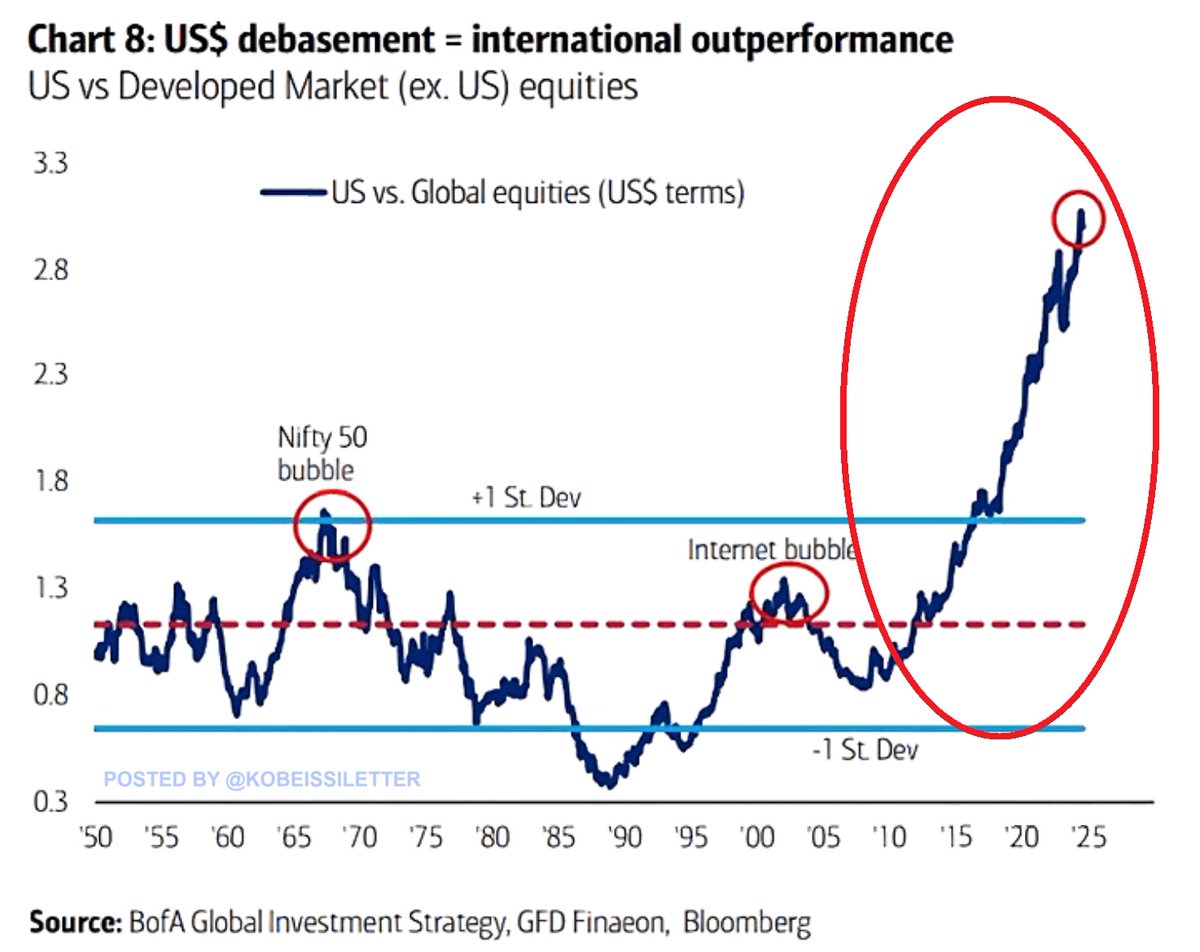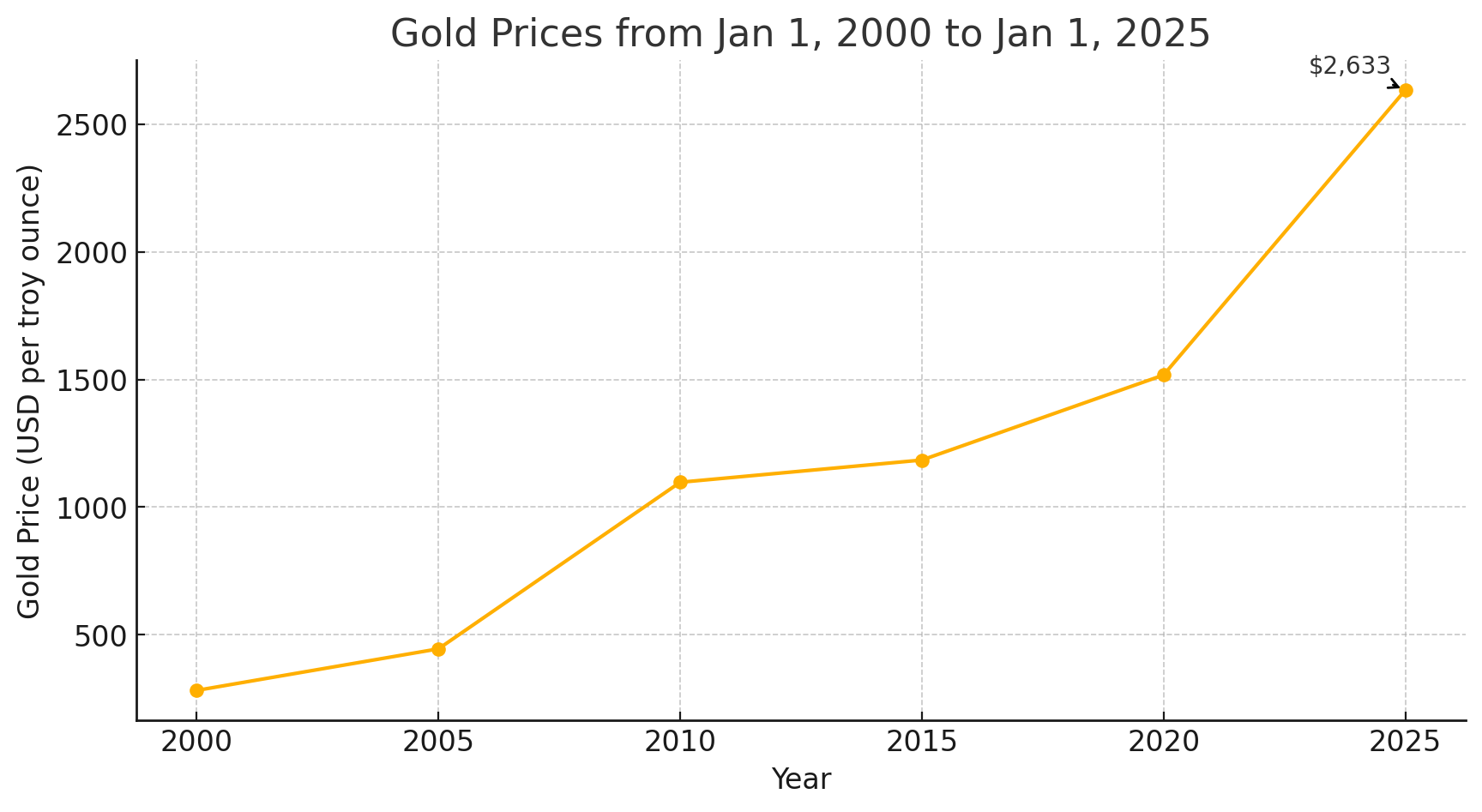
What to Expect During a Recession
- Stock markets decline, with prices dropping 20-50% or more, along with reduced or eliminated dividends.
- Retirement funds suffer, hit by both market downturns and inflation, creating a double financial blow.
- Unemployment rises, making job security more uncertain.
- Wages, benefits, and hours decrease, while bonuses are often eliminated.
- Debt burdens surge, impacting individuals, corporations, and governments.
- Foreclosures, car repossessions, and bankruptcies increase as financial strain intensifies.
- Government tax revenue declines, leading to cuts in public services and programs.
- Families and communities struggle, as more parents, children, and friends find themselves in need.
US to Developed Market - Where We Are Now
The U.S. stock market is enormous (see chart below). The ratio of U.S. stocks to developed market equities recently reached a record high of approximately 3.0x. Over the past decade, this ratio has doubled as U.S. stocks are extremely overvalued compared to their global counterparts.

Investors Buy Gold During Recessions to Thrive
Recessions are typically defined as at least two consecutive quarters of declining economic output. While some recessions prior to 2000 used to be milder, more recent downturns have been extremely volatile, with both economic activity and stock markets experiencing significant losses.
During economic contractions, business performance weakens, unemployment rises, and consumer spending declines. This leads to lower corporate profits and falling stock prices, negatively impacting investment portfolios.
Even during recessions, especially ones with severe volatility, investors must find ways to safeguard their assets—Particularly those saving for retirement with significant holdings in tax-advantaged accounts such as IRAs, 401(k)s, pension funds, annuities, TSPs, and inherited retirement accounts. Since these accounts are often heavily invested in the stock market, market crashes can put retirement savings at serious risk.
When stock markets decline or show signs of crashing, investors seek safer assets that can preserve value during a recession—such as gold and cash. However, for those with tax-advantaged retirement accounts, holding cash isn't always an option due to potential tax liabilities. So, what’s the best solution?
Investors aware of their choices turn to a Gold Retirement Account/IRA, which allows them to roll over existing retirement accounts into physical gold without paying taxes or losing the tax deferred benefits. Unlike paper investments, gold has no third-party counterparty risk and historically gains value during recessions. A Gold IRA provides the same tax advantages as traditional retirement accounts while offering protection against stock market volatility, currency depreciation, inflation, bond market crashes, and offers asset appreciation in gold prices—making it a strategic hedge in uncertain times.
Gold as a Reliable Portfolio Diversifier
Finding truly effective diversifiers can be challenging, as many assets become increasingly correlated during periods of heightened market uncertainty and volatility. This is largely due to risk-on/risk-off investment behaviors, where investors shift between riskier and safer assets. As a result, many traditional diversifiers fail to provide protection precisely when it is needed most.
Gold stands apart because it frequently moves in the opposite direction of equities (stocks) and other risk assets, particularly as the dollar loses value and government debt continues to rise.
It has consistently outperformed during recessions and periods of uncertainty. While this has been evident since the U.S. severed the dollar from gold in 1971, gold’s role as a safe-haven asset has become even more crucial since 2000.
Since 2000, the U.S. has faced three major recessions:
- 2001 Dot-Com Crash
- 2008 Financial Crisis (Great Recession)
- 2020 COVID Crisis and its aftermath
The Federal Reserve’s response to each crisis has been to print money to mitigate the downturn. However, each time, the velocity and scale of money printing have increased exponentially to achieve the same economic effect. This excessive monetary expansion devalues the dollar’s purchasing power and remains a primary driver of inflation. When recession and inflation hit simultaneously, it creates a double financial blow for savings and retirement accounts.
More recently, gold prices have continued to rise through 2024 and into the first quarter of 2025, as smart money, financial institutions, countries, and investors prepare for an inevitable recession—or worse. Since 2000, buying gold sooner rather than later has proven to be a prudent financial strategy.

Gold Demand During Recessions: 3 Key Factors
Physical gold is one of the few assets that investors and countries rely on to safeguard their portfolios and net worth during economic downturns. Its demand in and of itself causes the price of gold to rise. Here are three key factors that drive demand for gold.
1) Flight to Safety
No investor wants to experience losses. While we all understand that risk is an inherent part of investing, the reality of losing money can be difficult to endure. This is why many investors aim to minimize risk. Although completely avoiding losses is impossible—especially during recessions—gold’s rising value can help offset declines in other assets and even grow your net worth.
The run to gold: Gold has performed extremely well {See graph above}
The run to cash: Inflation has eroded the purchasing power of cash dramatically since 2020. Since 2000, the dollar has lost more than 40% of its purchasing power, while gold is well above a 700% increase.
The run to bonds: Those that ran to bonds in 2020 as a flight to safety, for the most, faced a different outcome. In March 2020, interest rates were close to zero. Due to trillions of dollars being printed and the country racking up debt, by 2022 inflation hit hard, and interest rates had to be raised quickly… in 2023 the U.S. faced one of the worst bond market collapses in the last 100 years and the worst bank failures since the ’08 financial crises.
2) Uncertainty, Fear, and Volatility
Fear and uncertainty about the future, along with market volatility, are key drivers of increased demand for gold. When stock markets decline, housing markets weaken, or economies enter a recession— the duration and severity remain unknown. A downturn could resolve in six months, or it could stretch for years. Markets might recover quickly, or they could experience prolonged losses, with stock values and home prices potentially plummeting by half.
Even countries cannot predict with certainty when or how these major economic events will begin or end, which is why they too purchase massive amounts of physical gold. The stability gold provides makes it one of the most important assets in history. An added advantage for smart investors is that physical gold has performed well not only during economic downturns but also in prosperous times.
3) Strategic Hedge
No one should put all their eggs in one basket—not even in gold. However, by protecting a significant percentage of your net worth with physical gold, not only can you effectively hedge your portfolio, but you can also achieve large profits over the long term.
Not everyone wants to protect a sizable portion of their net worth or portfolios with gold. Some only feel comfortable investing 10-20% to look for more of just a cushion.
Those kinds of decisions are up to each individual person to make, but it is important to know that as more and more investors are buying gold as a hedge, the price is increasing.
The Two Ingredients that Cause Larger Recessions & Consequences
Recessions stem from economic, financial, and external disruptions that slow growth and cause contraction. Before listing the key recession triggers, it's crucial to highlight two aggressive measures the federal government has overused in the last three major downturns—worsening each new crisis and exacerbating future crises even more.
Holding interest rates too low for too long and excessive money printing go hand in hand in creating dangerous cycles:
- Low rates & money printing → inflated asset prices & speculative bubbles.
- Inflation rises → Purchasing power weakens.
- Central bank raises rates → crashes, credit crunches, & recessions.
Government prints more money to “fix” it → Cycle starts again.

Bigger and Bigger Bubbles → Greater Economic Instability & Volatility
Each round of money printing to "band-aid" the next recession leads to progressively larger Boom-to-Bust Cycles, each becoming more volatile than the last. With every cycle, recessions and financial crises worsen.
Take, for example, the 2001 Dot-Com crisis—in response, the Fed printed money, racked up debt, and aggressively slashed interest rates from 6% in January 2001 to 1.75% by December 2001, reaching a historic low of 1% by 2003. These aggressive policies directly fueled the next, even larger boom-to-bust cycle—the 2008 Mortgage-Backed Securities (MBS) Crisis. This collapse triggered a massive freefall in nearly every dollar-denominated asset.
To stop the financial meltdown, the government enacted even more extreme intervention than in 2001. In addition to slashing interest rates from 5.25% (September 2007) to 0.25% (December 2008), they printed exponentially more money, purchased their own debt (bonds), and issued massive financial bailouts.
Between Jan 2009 and December 2018, interest rates were only able to be raised as high as 2.50% before more economic turbulence rose. The overnight repo market in September 2019 had to be given an emergency injection of money to keep it from spiraling as liquidity dried up. The Fed lowered interest rates in addition to injecting money into the system.
By March 2020 when the COVID pandemic hit, interest rates were at 1.75%. In response to the economic turmoil caused by the 2020 COVID-19 pandemic, the Federal Reserve implemented several aggressive measures to stabilize the economy:
- Interest Rate Cuts: On March 3, 2020, the Federal Reserve cut interest rates from 1.75% to 1.25%, marking the largest emergency rate cut since the 2008 financial crisis. Subsequently, on March 15, the Fed further slashed the rate to a range of 0.0% to 0.25%.
- Quantitative Easing (Money Printing): Alongside the March 15 rate cut, the Fed announced a $700 billion quantitative easing program, purchasing Treasury securities and mortgage-backed securities.
- Corporate Debt Purchases: On March 17, 2020, the Fed introduced a program to buy up to $1 trillion in corporate commercial paper, ensuring that credit continued to flow within the economy.
- Unlimited QE and Additional Facilities: On March 23, the Federal Reserve expanded its money printing program without specifying an upper limit and reactivated the Term Asset-Backed Securities Loan Facility. This move aimed to support various financial markets, including corporate bonds, exchange-traded funds, small business loans, mortgage-backed securities, student loans, auto loans, and credit card loans.
- Support for Small Businesses and Governments: On April 9, 2020, the Fed announced $2.3 trillion in loans to support small businesses, as well as state and local governments, further bolstering economic stability during the pandemic.
By examining the unprecedented government intervention during the 2020 COVID crisis, which extended far beyond its initial purpose, it’s clear that future recessions will demand even greater stimulus, bailouts, and interventions.
If money printing and debt continues unchecked to counter recessions and crisis, it will eventually trigger horrific debt crises with painful inflation that leads to the eventual collapse of the financial system, ultimately forcing a major monetary reset. Historically, such resets have often led nations back to gold-backed currencies as a means of restoring stability.

What Causes Recessions?
Stock Market Crashes → Wealth Destruction & Panic
- Market crashes lead to a rapid loss of investor confidence, reducing household wealth and spending.
- Businesses struggle as capital dries up, leading to layoffs and declining economic output.
Prolonged Low Interest Rates → Create Asset Bubbles & Debt Crises
- When interest rates remain too low for too long, borrowing becomes cheap, leading to excessive debt in housing, stocks, and corporate markets.
- This creates asset bubbles, which eventually burst, triggering widespread financial instability.
Excessive Debt (Household, Corporate, and or Government) → Debt Crises & Defaults
- When businesses, households, or governments accumulate unsustainable debt, they struggle to repay loans.
- This results in defaults, bankruptcies, and a financial crisis.
Money Printing Creates Asset Bubbles → Leads to Larger Boom-and-Bust Cycles
- When central banks print excessive amounts of money, that money often flows into stocks, real estate, and speculative assets rather than productive investments.
- This artificially inflates asset prices, creating bubbles that eventually burst, triggering financial crises and recessions.
- Example: The 2000 Dot-Com Bubble & 2008 Housing Bubble were fueled by cheap credit and excessive liquidity.
The amount of money printed in 2020 to stop the world economy from a complete free fall is staggering and makes the 2008 money printing look like a needle in a haystack. We are currently either still in the bubble up (boom) cycle or at the beginning stages of bursting (bust) cycle.
Inflation Surges, Raising Interest Rates→ Reduced Purchasing Power & Economic Slowdown
- Rapid price increases reduce consumer spending power, making essentials like food and energy unaffordable.
- To fight inflation, central banks raise interest rates, often pushing the economy into a recessionary spiral.
- Higher rates also lead to loan defaults and bankruptcies for businesses and individuals, creating tighter financial conditions.
Banking & Credit Crises → Liquidity Shortages & Business Failures
- Bank failures causes tightening of lending conditions which causes credit to dry up, restricting business operations and consumer borrowing.
- Run on Banks—Banks make risky investments and as they decline, people hurry to withdraw their funds causing a collapse in the financial institution.
- Bank failures causing crisis/recessions date back to the inception of banks.
Trade Wars & Tariffs → Slower Growth & Higher Prices
- Restrictions on global trade leads to higher costs for businesses and consumers, reducing economic efficiency.
- Retaliatory tariffs create uncertainty, stifling business investments and job creation.
Geopolitical Conflicts & Wars → Economic Disruptions & Supply Chain Disruptions
- Military conflicts lead to government overspending, inflation, and trade disruptions.
- Uncertainty from global tensions causes business slowdowns and stock market volatility.
- Wars, natural disasters, or pandemics can disrupt supply chains, leading to shortages and higher prices.
- Businesses struggle to meet demand, resulting in layoffs and factory closures.

The 5 Ways to Prepare So You Can THRIVE
1. Add Gold to Your Portfolio
Gold has historically protected wealth during recessions, inflation, and financial crises. Unlike paper assets, gold retains its value, serves as the ultimate form of money, carries no third-party counterparty risk, and cannot be controlled by any single country.
✔ Hedge against inflation—gold often rises as fiat currencies lose value.
✔ Preserve purchasing power when markets decline.
✔ Diversify your portfolio with a tangible, non-dollar denominated asset that has stood the test of time.
✔ Protect retirement savings by adding physical gold to an IRA or buy for direct delivery.
2. Build an Emergency Fund
A financial safety net is crucial when income becomes uncertain. Avoid dipping into retirement accounts during a market downturn, as withdrawals lock in losses and may trigger penalties.
✔ Aim to save at least one year’s worth of expenses.
✔ Look for passive income sources to supplement cash flow.
✔ Keep funds liquid—avoid locking them in CDs that lose value against inflation.
3. Stock Up on Essentials
Supply chain disruptions and inflation can lead to shortages and price spikes. Be proactive.
✔ Stockpile nonperishable food and essential household items.
✔ Keep a reserve of medical and personal necessities.
✔ Plan ahead—rising costs and scarcity may affect everything from groceries to electronics.
4. Optimize Cash Flow
Managing income and expenses wisely helps stretch your resources.
✔ Cut unnecessary expenses.
✔ Delay major purchases if possible.
✔ Avoid taking on new debt.
✔ Reduce losses on weak investments, but don’t panic sell.
5. Pay Down Debt
If possible, without draining your emergency fund— reduce debt to alleviate financial strain and increase flexibility.
✔ Debt keeps growing even if your income declines.
✔ Higher interest rates make borrowing more expensive.
✔ Freeing up credit provides a safety cushion for emergencies.
✔ New credit lines may become harder to access and more costly.
Data from the Pew Research Center and other sources show that the American middle class has steadily declined after each recession since 2000. With every downturn, fewer adults remain in the middle class, as more people fall into the lower income bracket while a smaller portion move into the upper tier. At the same time, research from psychologists and economic experts indicates a rising correlation between economic downturns and mental health struggles. Since 2000, diagnoses of anxiety, depression, and other mental health conditions have increased with each major recession, particularly following the 2020 COVID pandemic. These trends highlight the deep financial and psychological impact of economic instability on American households.
By taking proactive steps to prepare for economic downturns and unexpected financial challenges, you won’t just experience greater peace of mind— you can THRIVE— You’ll place yourself in the position to seize opportunities to grow your wealth.
“By failing to prepare, you are preparing to fail.”
~ Benjamin Franklin
“If you don’t own Gold, you know neither history nor economics.”
~ Ray Dalio, Hedge Fund Manager at Bridgewater Associates
Why Harvard Gold Group?
Harvard Gold Group is America's #1 Conservative Gold Company
As seen on 660AM The Answer with Mark Davis, The Babylon Bee, Not The Bee, The Christian Post, The New York Sun, and more. Exceptional customer service and value are the top priorities of Harvard Gold Group (HGG).
HGG is BBB A+, holds 5-star ratings across the board, and provides free consultations and metals overviews. We offer tax-free purchases, free 2-day shipping, the best pricing, and direct access to our co-owners, who have over 16 years of experience specializing in precious metals, moving over $100 million into tangible assets for people's IRAs/retirement accounts and for direct delivery. Customers enjoy lifetime account care and a straightforward buyback program without hassle or liquidation fees.
✔ Tax-Free & Penalty-Free: A Rollover or Transfer of your Retirement Account is almost always tax-free and penalty-free.
✔ Free Metals/Promos: Earn up to $15,000 in FREE Gold/Silver/Promos, on qualifying purchases.
✔ Free Retirement Account Rollover/Transfer: Zero cost to rollover/transfer/move retirement accounts or IRAs to a Gold/Silver IRA. *You can also earn up to 10 years of Precious Metals IRA yearly maintenance fees*.
✔ Privacy: We protect your privacy and believe it is a commodity as valuable as time, you can't get it back. We do not sell your information to third parties.
✔ HGG Lifetime Account Care: Providing a dedicated account specialist and keeping you updated with market news and trends.
✔ Harvard BuyBack Program: Hassle-free buyback of HGG metals with no liquidation fees.
✔ Guaranteed Precious Metals: We only deal in government-issued coins and branded bars.
✔ Free Shipping: Your precious metals are shipped privately and fully insured to the location of your choice. You can opt to have them delivered directly to your home, business, or an independent depository.
✔ Lowest Pricing: We are committed to offering you the best value possible, with a comprehensive price-match policy.
✔ Customer Satisfaction Guarantee: Harvard Gold Group is a 5-star rated company committed to maintaining exceptional customer service satisfaction.
✔ You work directly with the founders of HGG.


